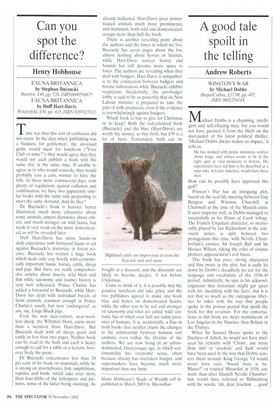Can you spot the difference?
Henry Hobhouse
FAUNA BRITANNICA by Stephan Buczacki Hamlyn, £40, pp. 528, ISBN0600598675 FAUNA BRITANNICA by Duff Hart-Davis Weidenfeld, £30, pp. 415, ISBN 0297825321 Time was that this sort of confusion did not occur. In the days when 'publishing was a business for gentlemen', the aforesaid gents would meet for luncheon ('Your Club or mine?'); they would agree that they would not each publish a book with the same title at the same time. If unable to agree as to who would concede, they would probably toss a coin, winner to have the title. In these more commercial days, with plenty of regulations against collusion and combination, we have two apparently similar books with the same title purporting to meet the same demand. And do they?
Dr Buczacki's book is heavier, better illustrated, much more exhaustive about some animals, almost dismissive about others, and much stronger on wild fauna, but weak to very weak on the more domesticated, as will be revealed later.
Duff Hart-Davis has more hands-on daily experience with farmyard fauna to set against Buczacki's doctorate in forest science. Buczacki has written a huge book which deals only very briefly with economically important fauna: horses, cattle, sheep and pigs. But there are really comprehensive articles about insects, wild birds and fish while taxonomy and (some) history is very well rehearsed. Prince Charles has added a foreword to Buczacki, while HartDavis has dealt with individual breeds of farm animals, common enough in Prince Charles's youth, but now 'endangered' as are, say, Large Black pigs.
Even the now near-extinct, near-woolless sheep, the Wiltshire Horn, earns more than a mention from Hart-Davis. But Buczacki deals with all sheep, goats and cattle in less than two pages. Neither book can be read in the bath and each is heavy enough to call for a table or a lectern, however lively the prose.
Dr Buczacki concentrates less than 20 per cent of his book on mammals, while he is strong on invertebrates, fish, amphibians, reptiles and birds, which take over more than four-fifths of the letterpress and pictures, some of the latter being stunning. As already indicated, Hart-Davis gives domesticated animals much more prominence, and mammals, both wild and domesticated, occupy more than half the book.
There is another revealing point about the authors and the times in which we live. Buczacki has seven pages about the fox, almost nothing about horses or hounds, while Hart-Davis notices horses and hounds but still devotes more space to foxes. The authors are revealing when they deal with badgers. Hart-Davis is sympathetic to the connection between badgers and bovine tuberculosis while Buczacki exhibits scepticism. Incidentally, the pro-badger lobby is said to be so powerful that no New Labour minister is prepared to take the part of milk producers, even if the evidence is overwhelmingly against badgers.
Which book to buy to give for Christmas or to keep? Both the red-coloured book (Buczacki) and the blue (Hart-Davis) are worth the money; so buy both, but £70 is a lot of lucre. Fortunately both can be bought at a discount, and the discounts are likely to become deeper, if not before Christmas.
Come to think of it, it is possible that the putative luncheon did take place and the two publishers agreed to make one book blue and better on domesticated beasts, while the other was to be red and stronger on taxonomy and what are called 'wild' animals, but of which over half are today parasites of humans. It is, incidentally, a flaw in both books that neither charts the changes in the relationship between humans and animals, even within the lifetime of the authors. We are now living in an urbandominated. Disneyesque age, in which sentimentality has overcome sense, often because obesity has overtaken hunger, and supermarkets have become much more important than any farm.
Henry Hobhouse's Seeds of Wealth will be published in March 2003 by Macmillan.


























































































 Previous page
Previous page